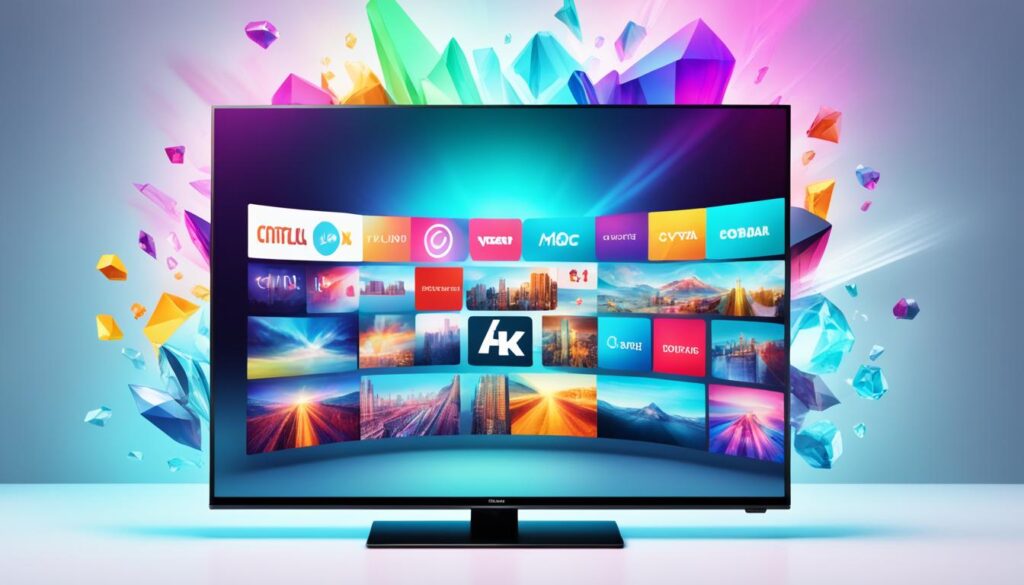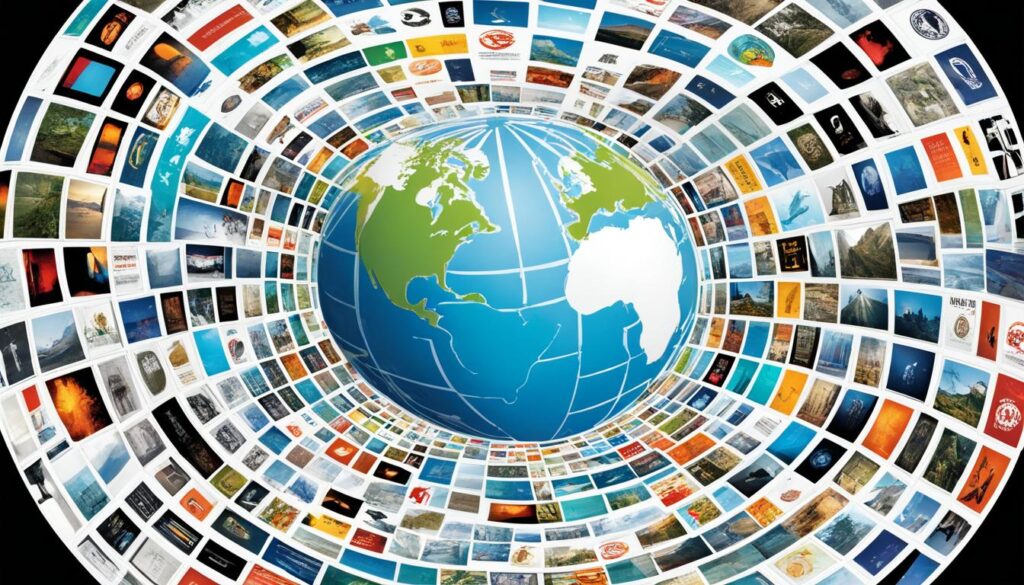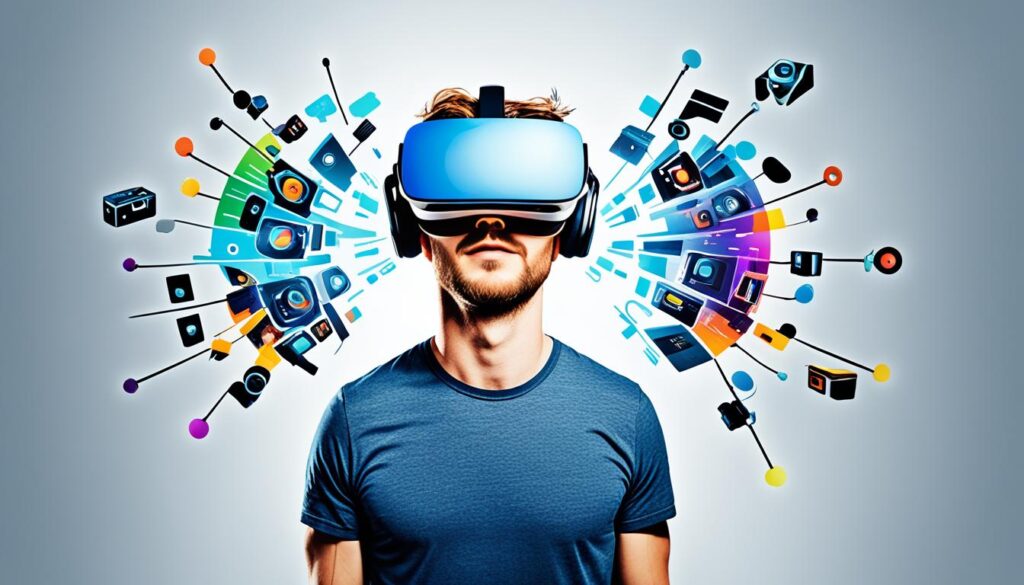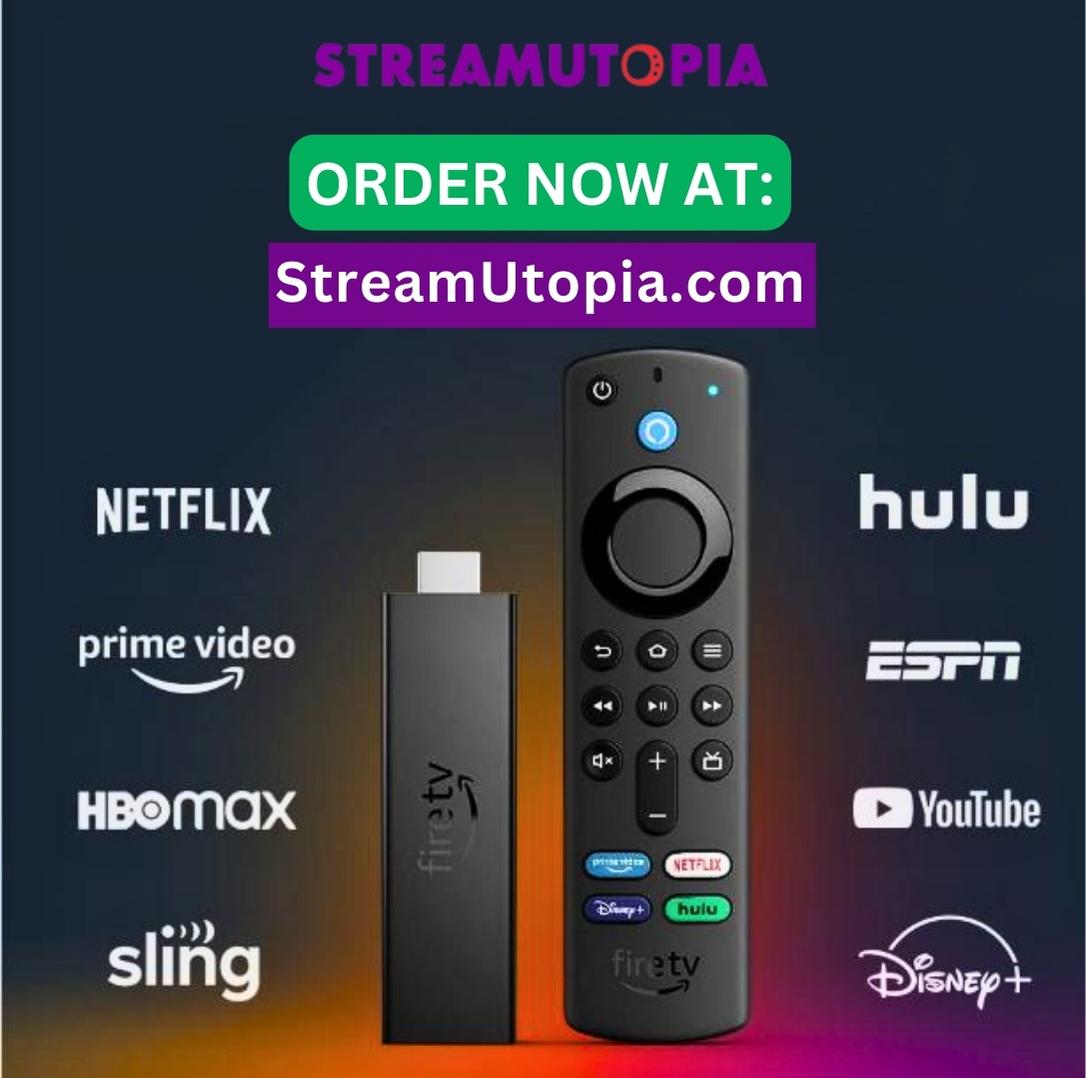Did you know that the global IPTV market is expected to reach a staggering $71.5 billion by 2022? That’s not all, this market is projected to grow at a remarkable rate of 15.7% from 2024 to 2028, highlighting the surging popularity and adoption of IPTV as a media consumption option. With advancements in technology and the rise of streaming services, IPTV is shaping the future of TV trends and revolutionizing the way we enjoy television content.
Key Takeaways:
- The global IPTV market is expected to reach $71.5 billion by 2022, with a projected growth rate of 15.7% from 2024 to 2028.
- IPTV is becoming increasingly popular as a media consumption option, thanks to advancements in technology and the rise of streaming services.
- The future of IPTV is marked by key trends such as 5G integration, AI-powered recommendations, and interactive viewing experiences.
- Advancements in content delivery and viewing devices have enhanced the overall IPTV experience, with 4K streaming and multi-device compatibility becoming more prevalent.
- IPTV is not just transforming how we consume media but also finding integration in smart homes and contributing to sustainability initiatives.
Evolution of IPTV
IPTV, which stands for Internet Protocol Television, has undergone significant evolution since its inception in the 1990s. The concept initially faced technical challenges due to limited bandwidth and infrastructure. However, with the advancements in technology and the rise of streaming services, IPTV has become a widespread phenomenon in the world of entertainment.
Today, viewers have the convenience and flexibility to access a wide range of television content through the internet, thanks to streaming services and high-speed internet availability. This shift has led to the emergence of internet television, commonly known as IPTV. With IPTV, viewers can enjoy a vast library of on-demand content, breaking free from the limitations of traditional broadcasting schedules.
IPTV has revolutionized the way we consume television, providing a seamless digital TV experience. It offers numerous benefits, such as the ability to watch content on multiple devices, including smartphones, tablets, and smart TVs. With IPTV, viewers can enjoy their favorite shows and movies anytime, anywhere, without being tied to a physical television set.
Streaming services have played a pivotal role in the evolution of IPTV. Providers like Netflix, Hulu, and Amazon Prime Video offer a wide range of streaming options, including live TV, on-demand content, and exclusive original series. These services have redefined the way we engage with television, allowing us to explore a diverse array of genres and discover new content suited to our interests.
High-speed internet has also been a game-changer for IPTV. With faster and more reliable connections, viewers can enjoy smooth streaming experiences without buffering or interruptions. This has paved the way for seamless high-definition and even 4K streaming, providing viewers with immersive visual quality that rivals traditional broadcast television.
Moreover, the rise of streaming services has led to increased competition in the entertainment industry. Traditional broadcasters and cable providers have adapted to the rise of IPTV by launching their own streaming platforms or partnering with existing platforms. This evolution has opened up new avenues for content creators, expanding their reach and allowing for a more diverse range of content.
Internet television, or IPTV, is undoubtedly the future of television. Its evolution continues to shape the way we consume media, offering innovative ways to connect with our favorite shows and discover new content. As technology advances and streaming services continue to thrive, IPTV will remain at the forefront of the digital entertainment revolution.
Advancements in IPTV Technology
As consumers increasingly turn to streaming services for their entertainment needs, IPTV platforms have been at the forefront of technological advancements. These advancements not only enhance the viewing experience but also provide users with more personalized and interactive options.
The Evolution of 4K Streaming
One of the key advancements in IPTV technology is the transition to 4K streaming. With four times the resolution of traditional high-definition content, 4K streaming offers viewers a more immersive and visually stunning experience. This technological leap brings the details of the content to life, making it feel like you’re right in the middle of the action.

AI-Powered Personalization
IPTV platforms are harnessing the power of artificial intelligence to provide personalized content recommendations. By analyzing user preferences, viewing habits, and demographic information, these platforms curate content tailored to individual interests. This level of personalization ensures that viewers are presented with relevant and engaging content, creating a more satisfying and enjoyable streaming experience.
Interactive Experiences
Interactive experiences have become increasingly popular in the world of IPTV. Viewers now have the opportunity to actively engage with the content they consume, whether through interactive quizzes, polls, or choose-your-own-adventure-style narratives. This level of interactivity not only keeps viewers hooked but also allows them to shape their own viewing experience, making it more engaging and memorable.
Global Documentary Television Market
Documentaries have witnessed a significant surge in popularity in recent years, captivating audiences with their ability to educate, inform, and entertain. According to a report by TechSci Research, the global documentary television market was valued at $11.65 billion in 2022, and it is projected to grow at a compound annual growth rate (CAGR) of 5.5% from 2024 to 2028.
In the age of streaming platforms like Netflix, Amazon Prime Video, and Disney+, viewers now have easy access to a vast library of documentary content. These streaming platforms have played a crucial role in expanding the reach and impact of documentary programming, allowing viewers to explore a wide range of topics from nature and history to social issues and true crime.
With the advent of streaming platforms, the documentary genre has grown beyond the boundaries of traditional television networks, reaching audiences worldwide. The availability of documentary content on streaming platforms has empowered viewers to choose from an extensive catalog and watch at their own convenience. This accessibility has not only broadened the scope of documentary content but also enabled diverse voices and perspectives to be heard.
Trends in the Global Documentary Television Market
The global documentary television market is witnessing several key trends that are shaping the future of the genre:
- The proliferation of documentaries on streaming platforms and the diversification of content cater to a wide range of viewer interests and preferences.
- Collaborations between streaming platforms and documentary filmmakers are resulting in high-quality, original productions that showcase compelling storytelling and innovative narratives.
- Interactive and immersive documentary experiences, including virtual reality (VR) and augmented reality (AR) formats, are gaining traction and giving viewers a more engaging and personalized way to experience the content.
- The rise of short-form documentaries and docuseries aligns with changing viewer habits and preferences for bite-sized, easily digestible content.
- Increasing demand for socially and environmentally conscious documentaries highlights viewers’ inclination towards content that addresses pressing global issues and fosters awareness and change.
The global documentary television market presents immense opportunities for content creators, filmmakers, and streaming platforms to explore diverse subjects, engage viewers, and make a meaningful impact. As the market continues to evolve, it is essential for industry players to keep abreast of these trends and adapt to changing viewer preferences, ensuring the continued growth and relevance of the documentary genre.

| Year | Market Value (in billions) |
|---|---|
| 2022 | $11.65 |
| 2023 | $12.17 |
| 2024 | $12.81 |
| 2025 | $13.44 |
| 2026 | $14.16 |
Evolution of Documentary Television
Documentary television has a long and fascinating history, predating the medium of television itself. Visionaries like Robert J. Flaherty and Dziga Vertov laid the foundation for the genre, capturing real-life stories and events on film. However, it was through television that documentaries found a wider audience and garnered mainstream attention.
Television networks played a crucial role in the evolution of documentary television. They recognized the power of nonfiction storytelling and the appetite of viewers for thought-provoking content. Icons like Sir David Attenborough and Ken Burns became synonymous with documentary filmmaking, creating timeless masterpieces that continue to captivate audiences to this day.
Advancements in technology have played a significant role in making documentaries more accessible. Traditional television networks and cable channels paved the way for documentary programming, offering a platform for filmmakers to share their stories. However, the rise of streaming platforms has revolutionized the accessibility of documentary content.
Streaming platforms like Netflix, Amazon Prime Video, and Hulu have created a global stage for documentaries, allowing viewers to explore a vast library of captivating stories at their convenience. These platforms have expanded the reach of documentary filmmakers and brought their work to audiences around the world.
The Evolution of Documentary Television: A Timeline
| Decade | Milestones |
|---|---|
| 1920s | Pioneering documentary filmmakers like Robert J. Flaherty and Dziga Vertov begin capturing real-life stories on film. |
| 1940s | The emergence of television as a medium brings documentaries to a wider audience. |
| 1960s | The advent of color television enhances the visual experience and captivates viewers. |
| 1980s | Television networks and cable channels become dedicated platforms for documentary programming, showcasing a diverse range of stories. |
| 1990s | The rise of the internet allows documentaries to reach audiences globally through online platforms and websites. |
| 2000s | Streaming platforms revolutionize the accessibility of documentaries, providing audiences with a vast library of content at their fingertips. |
Over the years, documentary television has undergone significant transformations. From black and white footage to high-definition visuals, the evolution of technology has elevated the production quality of documentaries, immersing viewers in the stories they tell.
The availability of documentary content on both traditional television networks and streaming platforms ensures that viewers have a wide range of choices. Whether it’s a historical documentary on a cable channel or a cutting-edge environmental documentary on a streaming service, there is something for everyone.
Documentary television continues to evolve, with filmmakers experimenting with new formats, storytelling techniques, and technological advancements. The genre’s ability to inform, educate, and entertain remains as strong as ever, ensuring that documentary television holds a vital place in the ever-changing landscape of media consumption.
Technological Advancements in Documentary Production
Technological advancements have greatly influenced the field of documentary production, revolutionizing the way filmmakers create and present their stories. These advancements have transformed the visual quality, narrative techniques, and overall viewer experience. Through the integration of various cutting-edge technologies, documentary production has reached new heights of creativity and engagement.
High-Definition and 4K Cameras
The use of high-definition (HD) and 4K cameras has become a standard practice in documentary production. These advanced cameras capture footage with remarkable clarity, rendering stunning visuals that immerse viewers in the story. With sharper details, vibrant colors, and enhanced depth, documentaries can now deliver a more captivating and realistic experience.
Virtual Reality and Augmented Reality
Virtual reality (VR) and augmented reality (AR) technologies have also made a significant impact on the documentary genre. Filmmakers have embraced these immersive technologies to transport viewers into unique and interactive storytelling environments. VR allows audiences to explore different perspectives and environments, while AR enhances the documentary experience by overlaying digital elements onto the real world.
Digital Editing Tools
Advancements in digital editing tools have revolutionized the post-production process of documentaries. Editing software like Adobe Premiere Pro and Final Cut Pro offer filmmakers a range of powerful tools to refine their storytelling techniques. These tools enable precise editing, seamless transitions, visual effects, and sound design, resulting in more polished and impactful documentaries.

Enhancing the Viewing Experience
Technological advancements in documentary production have not only influenced the creation process but also improved the viewer experience. Through the use of HD and 4K cameras, virtual reality, and augmented reality, documentaries can provide a more immersive and engaging journey for the audience. The integration of these technologies empowers filmmakers to craft compelling narratives that resonate with viewers on a deeper level.
| Technological Advancements | Benefits |
|---|---|
| High-definition and 4K cameras | Improved visual quality, sharper details, vibrant colors, enhanced depth |
| Virtual reality and augmented reality | Enhanced immersion, interactivity, and exploration of different perspectives |
| Digital editing tools | Precise editing, seamless transitions, visual effects, and sound design |
Overall, technological advancements in documentary production have opened up new possibilities for filmmakers to tell impactful stories and engage with audiences in innovative ways. As technology continues to evolve, we can expect further advancements that will shape the future of documentary production and the way we experience these compelling narratives.
Challenges and Opportunities in the Documentary Television Market
Despite the growth and popularity of the documentary television market, filmmakers and broadcasters face a unique set of challenges and opportunities in this dynamic industry. Producing high-quality documentaries requires substantial financial resources and securing funding can be a daunting task, especially for independent filmmakers who may not have access to established networks or production companies. The availability of funding greatly influences the success and reach of a documentary.
Another challenge in the documentary television market is distribution. With the rise of streaming platforms and digital content consumption, finding the right platform and audience for a documentary can be a complex process. Filmmakers need to navigate the landscape of streaming services, broadcasters, and online platforms to ensure their documentaries reach the intended viewership.
Furthermore, documentaries that delve into sensitive or controversial subjects can face censorship or legal challenges. The nature of documentary storytelling often pushes boundaries, and navigating legal and ethical considerations is essential for filmmakers. However, it is precisely this authenticity and social impact that make documentaries a powerful medium for storytelling and promoting positive change.
Despite these challenges, the documentary genre continues to thrive and attract audiences due to its unique storytelling approach, compelling narratives, and potential for social impact. Documentaries have the power to educate, inform, and drive conversations about important issues. They provide an opportunity for viewers to gain insights into different perspectives, fostering empathy and understanding.
Beyond the challenges, there are ample opportunities in the documentary television market. With the advent of streaming platforms and digital distribution channels, filmmakers have more avenues to showcase their work and reach a global audience. Additionally, partnerships with production companies, broadcasters, and streaming platforms can provide essential support in securing funding, expanding distribution, and amplifying the impact of documentaries.
Table:
| Challenges | Opportunities |
|---|---|
| Limited funding for independent filmmakers | Potential partnerships for funding and distribution |
| Complexities in distribution and finding the right platform | Expanding reach through streaming platforms and digital distribution |
| Censorship and legal challenges for sensitive subject matter | Authentic storytelling and potential for social impact |

The Future of Documentary Television
The future of documentary television is shaped by both technological advancements and evolving viewer preferences. As the world becomes more interconnected, documentary television is embracing innovative approaches to storytelling and engaging audiences in new and immersive ways.
The Power of Virtual Reality
Virtual reality (VR) technology has revolutionized the way documentaries are experienced. By wearing VR headsets, viewers can step into the story and feel like they are right there, witnessing the events unfold firsthand. This immersive experience brings documentaries to life in a whole new dimension, making the storytelling more impactful and emotionally engaging. VR technology enables filmmakers to transport viewers to distant locations, historic moments, and even simulate unique perspectives, offering a level of immersion that traditional television cannot match.
Documentary television is increasingly exploring the potential of VR technology to create a deeper connection between viewers and the subject matter. The combination of compelling storytelling and immersive visuals allows audiences to gain a better understanding of complex issues and experiences. By putting viewers in the shoes of the documentary subjects, VR enhances empathy and fosters a stronger emotional connection between the audience and the content.

The Rise of Short Documentaries
In today’s fast-paced world, where time is a valuable commodity, short documentaries have gained significant popularity. These bite-sized films cater to audiences with limited time and shorter attention spans. Short documentaries offer concise and impactful storytelling, allowing filmmakers to convey powerful messages in a compact format.
Streaming platforms and social media have played a crucial role in the rise of short documentaries. Platforms like YouTube, Vimeo, and Instagram provide accessible channels for filmmakers to showcase their work and reach a wide audience. The shorter format also lends itself well to sharing on social media platforms, making it easier for documentaries to gain viral attention and spark conversations.
A Multi-Platform Approach
Documentary television is no longer limited to the traditional television screen. The genre is expanding its reach and impact by embracing a multi-platform approach. Filmmakers are exploring alternative platforms and mediums to distribute their documentaries, reaching audiences on various devices and platforms.
Podcasts have become a popular avenue for documentary storytelling, allowing listeners to engage with the content while on the go. Interactive websites and mobile apps provide interactive elements and additional information, enhancing the overall documentary experience. This multi-platform approach enables viewers to engage with the content on their preferred platforms and devices, providing greater accessibility and convenience.
Addressing Important Issues and User-Generated Content
Documentary television continues to address important societal issues, providing a platform to raise awareness and inspire change. Climate change, social justice, and human rights are just a few of the pressing topics that documentaries have been tackling. By shining a light on these issues, documentaries have the potential to drive conversations, challenge perspectives, and foster social change.
Moreover, user-generated content is increasingly finding its way into documentaries. Filmmakers are incorporating footage, stories, and perspectives captured by individuals around the world. This participatory approach not only adds authenticity but also empowers audiences to actively contribute to the storytelling process.
The Future of Documentary Television
| Key Factors | Description |
|---|---|
| Virtual Reality | Immersive storytelling and audience engagement through VR technology. |
| Short Documentaries | Concise and impactful storytelling catered to audiences with limited time. |
| Multi-Platform Approach | Exploring alternative platforms and mediums beyond traditional television. |
| Addressing Important Issues | Raising awareness and inspiring change through documentaries. |
| User-Generated Content | Incorporating perspectives and experiences captured by individuals. |
Key Trends in IPTV
As IPTV continues to evolve, several key trends are shaping the future of this media consumption option. These trends include the integration of 5G technology, AI-powered recommendations, and interactive viewing experiences that enhance user engagement and satisfaction.
Integration of 5G Technology
The integration of 5G technology in IPTV is revolutionizing the streaming experience. With faster and more reliable connections, viewers can enjoy seamless streaming without buffering or interruptions. This technology also opens up possibilities for augmented reality (AR) and virtual reality (VR) experiences within the IPTV ecosystem, allowing users to immerse themselves in their favorite content like never before.
AI-Powered Recommendations
IPTV platforms are harnessing the power of artificial intelligence to provide personalized content recommendations. By analyzing user preferences, viewing history, and demographics, AI algorithms can suggest relevant and tailored content to enhance the user experience. These AI-powered recommendations ensure that viewers discover new shows, movies, and documentaries that align with their interests, creating a more engaging and enjoyable IPTV experience.
Interactive Viewing Experiences
Interactive viewing experiences are becoming increasingly popular in the world of IPTV. Viewers can now actively engage with the content they consume, further enhancing their immersion and enjoyment. Interactive features such as quizzes, polls, and interactive storytelling create a dynamic and participatory viewing experience. This level of interactivity allows viewers to have a more personalized and unique connection with the content, making IPTV a compelling choice for entertainment.
These key trends in IPTV – 5G integration, AI-powered recommendations, and interactive viewing experiences – are revolutionizing the way we consume and engage with television content. As advancements in technology continue, the future of IPTV holds even more exciting possibilities for the media consumption landscape.
Advancements in Content Delivery and Viewing Devices
Advancements in content delivery have transformed the way we enjoy IPTV, offering a superior visual and audio experience for viewers. With the increasing popularity of Ultra High Definition (UHD) and High Dynamic Range (HDR) content, IPTV platforms deliver stunningly clear images and vibrant colors that bring the content to life.
In addition to enhanced content quality, streaming platforms have expanded their device compatibility, ensuring that viewers can access IPTV on multiple devices. Whether it’s a smart TV, smartphone, tablet, or computer, the flexibility of IPTV allows viewers to indulge in their favorite programs and shows anytime, anywhere.
This seamless transition between devices enhances the overall viewing experience, allowing users to easily switch from one device to another without any disruptions. Whether you’re at home, on the go, or at the office, IPTV ensures that you never miss a moment of your favorite content.
Increase in 4K Streaming
One significant advancement in content delivery is the rise of 4K streaming. With four times the resolution of traditional high-definition content, 4K streaming provides viewers with a more immersive and detailed visual experience. From breathtaking landscapes to intricate details, 4K streaming allows for a more engaging and realistic viewing experience, especially for nature documentaries, sports events, and blockbuster movies.
Comparison of Content Delivery and Viewing Devices
| Content Delivery | Advantages |
|---|---|
| Ultra High Definition (UHD) and High Dynamic Range (HDR) content |
|
| Multiple Device Compatibility |
|
| 4K Streaming |
|
With advancements in content delivery and viewing devices, IPTV has revolutionized the way we consume media. From stunning visuals to seamless transitions between devices, IPTV offers a truly immersive and flexible viewing experience. Whether you prefer to watch on a big screen or on your smartphone, IPTV caters to your preferences and ensures that you can enjoy your favorite content anytime, anywhere.
Integration with Smart Homes and Sustainability Initiatives
With the rapid growth of IPTV and the increasing prevalence of smart home technology, the integration of IPTV into the smart home ecosystem offers exciting opportunities to enhance the overall entertainment experience. Through seamless integration with voice-controlled remotes, IoT devices, and home automation systems, users can easily control their IPTV content, creating a more convenient and personalized viewing experience.
One of the key advantages of this integration is the ability to centralize control over various entertainment devices within the smart home network. For instance, users can use voice commands to turn on their IPTV and adjust the volume without needing multiple remote controls or physical interaction with the devices. This simplifies the entertainment setup and provides a more intuitive way to interact with IPTV content.
Moreover, the integration of IPTV with smart home technology aligns with sustainability initiatives. As more households adopt energy-saving practices and strive for eco-friendly options, IPTV providers are investing in energy-efficient infrastructure to minimize power consumption. Additionally, advancements in set-top box designs and the use of recyclable materials contribute to the sustainability goals of the entertainment industry.
In line with these sustainability efforts, IPTV providers are exploring eco-friendly options for set-top boxes and other devices. This includes using environmentally friendly materials, improving energy efficiency, and seeking ways to minimize electronic waste. By prioritizing sustainability, IPTV providers are not only reducing their environmental footprint but also promoting eco-conscious choices among consumers, providing them with eco-friendly options that align with their values.
The integration of IPTV with smart homes and sustainability initiatives ensures a seamless and enhanced entertainment experience while also contributing to a greener and more sustainable future.
Conclusion
The future of IPTV is set to shape the entertainment industry with exciting developments and innovative trends. Advancements in technology have paved the way for personalized recommendations, interactive experiences, and seamless content delivery, revolutionizing the way we consume media. As viewers increasingly seek immersive and tailored experiences, IPTV is at the forefront, providing innovative solutions to meet their demands.
With its bright future, IPTV will continue to evolve and adapt to the changing landscape of media consumption. The entertainment industry will benefit from the seamless integration of IPTV into our daily lives, offering a wide array of content choices and enhanced user experiences. As the industry progresses, IPTV will play a vital role in delivering engaging and memorable entertainment experiences to viewers worldwide.
As we look ahead, the future of IPTV holds great promise. Its ability to provide personalized and immersive experiences will shape the future of the entertainment industry. With its continuous advancements, IPTV will continue to redefine how we enjoy television, paving the way for a new era of entertainment.
FAQ
What is IPTV?
How does IPTV work?
What are the advantages of IPTV?
What is 4K streaming?
How does artificial intelligence enhance IPTV?
What are interactive viewing experiences in IPTV?
What is the global market size of documentary television?
How has streaming platforms impacted documentary television?
How has technology influenced documentary production?
What are the challenges in the documentary television market?
What is the future of documentary television?
What are the key trends in IPTV?
How has content delivery and viewing devices evolved in IPTV?
How is IPTV integrated with smart homes?
What are sustainability initiatives in IPTV?
What does the future hold for IPTV?






